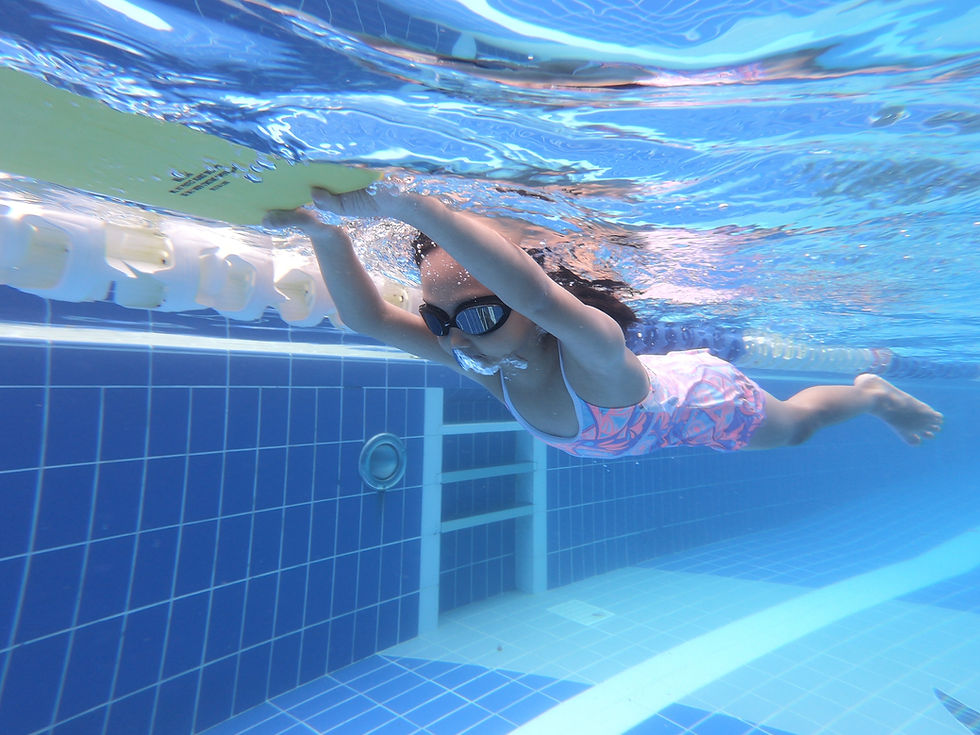Developing Consistent Kick Patterns: Tempo-Based Freestyle Drills
- SG Sink Or Swim

- Aug 25, 2025
- 2 min read

Freestyle, often seen as the fastest and most efficient stroke, relies heavily on the rhythm and strength of the kick. While arm movement drives most of the propulsion, the legs play a critical role in maintaining balance, rhythm, and overall efficiency in the water. One of the best ways to build this rhythm is through tempo-based freestyle drills, which help swimmers establish consistent kick patterns and reduce wasted energy.
In this article, we’ll explore the importance of kick consistency, the role of tempo, and practical drills to integrate into your freestyle training.
🌊 Why Kick Consistency Matters in Freestyle
A powerful, rhythmic kick provides benefits beyond propulsion:
Stability: It keeps the body streamlined and prevents unnecessary rolling or sinking.
Efficiency: A steady kick reduces drag and conserves energy for the arms.
Timing: Consistent kicks sync with the arm stroke for smoother movement.
Endurance: A practiced, efficient kick reduces fatigue in longer swims.
Many swimmers, especially beginners, struggle with irregular or frantic kicks. That’s where tempo-based training comes in.
⏱️ The Role of Tempo in Freestyle Kicking
Tempo in swimming refers to the timing and rhythm of strokes and kicks. By focusing on kick tempo, swimmers can avoid:
Over-kicking (wasting energy)
Under-kicking (losing balance and propulsion)
Uneven kicks that disrupt body position
Training with a consistent kick tempo develops a steady rhythm that can be adapted for sprinting, middle distance, or endurance freestyle.
🏊 Tempo-Based Freestyle Kick Drills
1. Kick with a Tempo Trainer
Use a FINIS Tempo Trainer or waterproof metronome.
Set the device to beep at a specific tempo (e.g., every 0.6–0.8 seconds).
Match each kick or kick cycle to the beep.✅ Builds awareness of kick rhythm and prevents random kicking.
2. Kickboard Tempo Intervals
Hold a kickboard and kick across the pool at a consistent rhythm.
Start with a slow tempo for control, then increase the tempo for sprints.
Alternate between 6-beat, 4-beat, and 2-beat kick patterns to feel the differences.
3. Vertical Kick with Tempo
In deep water, perform a vertical flutter kick with arms crossed.
Sync your kicks with a set tempo (start slower, then increase).
Aim to maintain balance without excessive splashing.✅ Improves leg strength and tempo control without forward motion.
4. Kick-to-Stroke Synchronization Drill
Swim freestyle focusing on matching a 2-beat or 6-beat kick pattern with your arm strokes.
For example, in a 2-beat kick, one kick happens with each arm pull.✅ Teaches efficiency and balance, especially for distance swimmers.
5. Breath-Control Kick Drill
Kick with a snorkel or while holding breath for a set number of kicks.
Focus on maintaining tempo even under fatigue or breath-hold stress.✅ Boosts endurance while reinforcing consistent rhythm.
⚡ Tips for Success
Start with a manageable tempo and gradually increase.
Record yourself or ask a coach to check kick consistency.
Alternate between short sprints and longer endurance sets.
Always prioritize relaxed ankles and a streamlined body position.
✅ Conclusion
Consistent kick patterns are the foundation of efficient freestyle swimming. By integrating tempo-based freestyle drills, swimmers can improve rhythm, balance, and endurance while conserving valuable energy for races or training. Whether you’re a beginner learning rhythm or an advanced swimmer fine-tuning for competition, tempo-focused kicking drills are a game-changer in building efficiency.





Comments